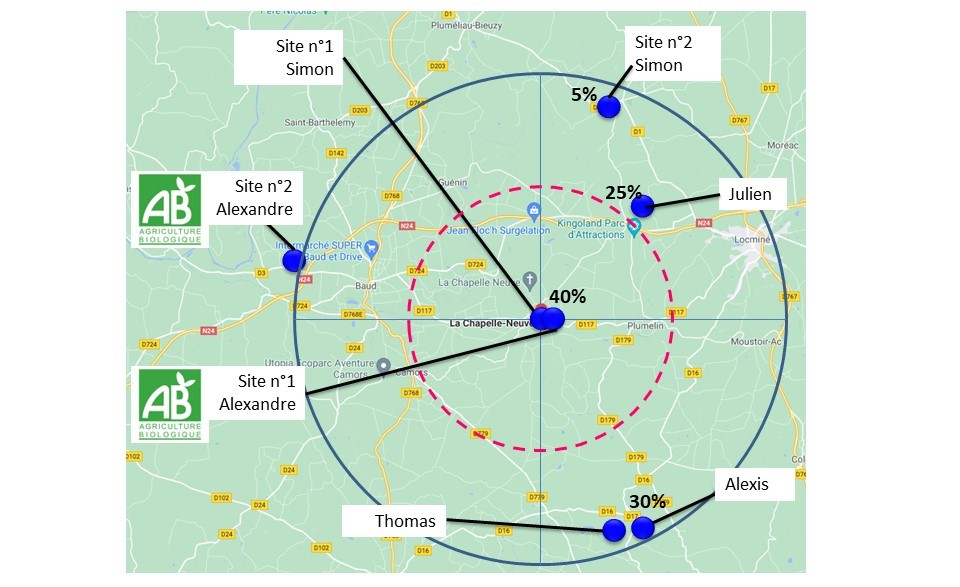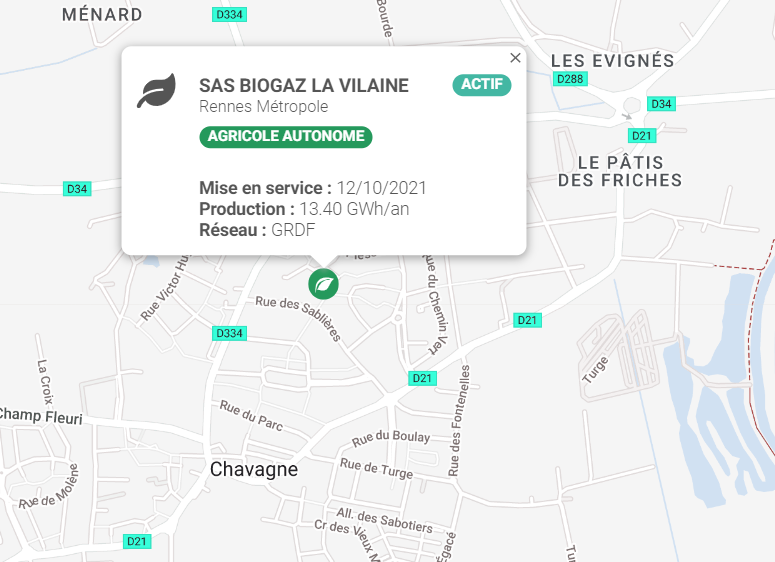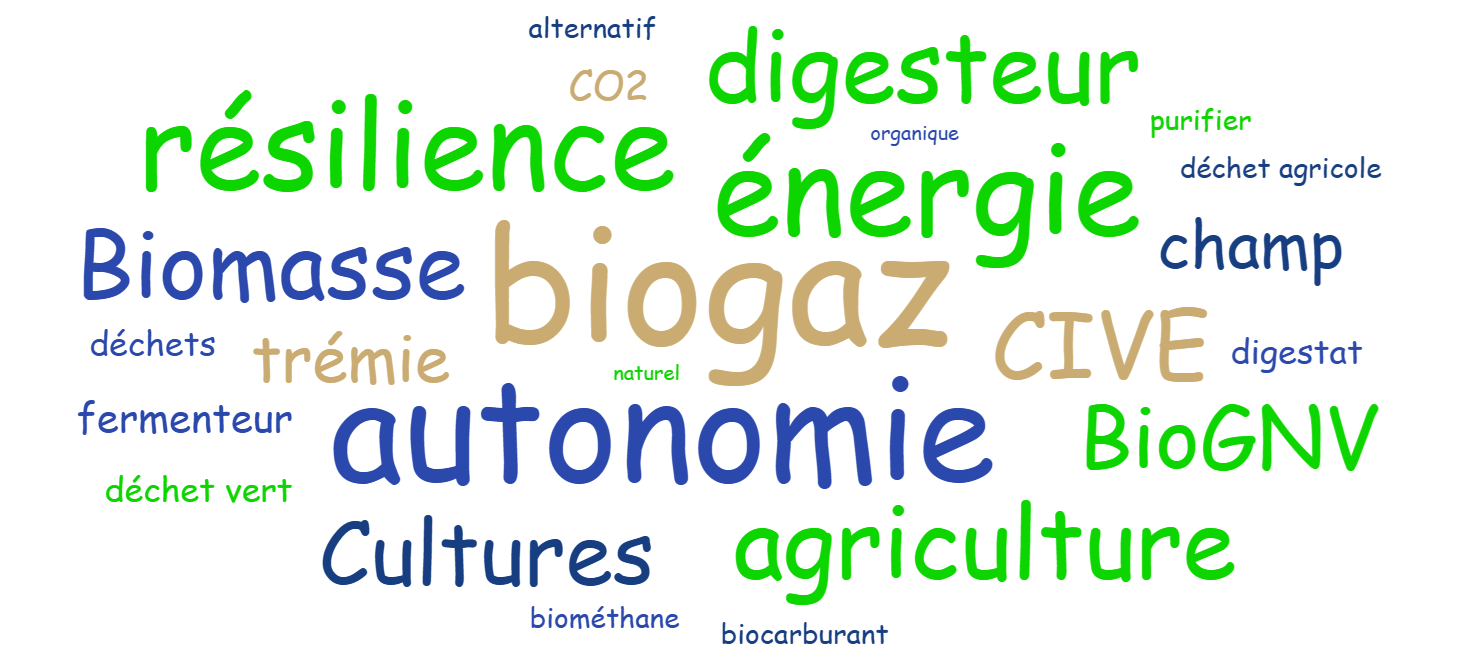
Anaerobic digestion is a key advancement in the energy transition towards a more sustainable future, allowing the conversion of agricultural organic waste into renewable energy. This technology offers numerous environmental benefits, such as reducing greenhouse gas emissions and producing natural fertilizers, as well as social and economic advantages, such as creating local jobs and promoting a circular economy, while providing controllable energy to the region.
Specifically, the project aims to produce biogas from 52.7 tons/day of purely agricultural organic waste, through a collective, human-scale anaerobic digestion unit. This project will produce 11 GWh/year of biogas injected into the distribution network at 116 Nm3/h*, enough to heat the equivalent of 2,500 new homes (each consuming 4,400 kWh/year) while utilizing the solid residues from the digestion process to transform them into natural fertilizers. This will reduce dependence on chemical (fossil-derived) fertilizers and contribute to more sustainable agriculture.
By promoting short economic and energy circuits, the project allows for efficient use of local resources while contributing to a sustainable energy transition. The conversion of organic waste into biogas and natural fertilizers will reduce dependence on fossil fuels, create local jobs, and decrease greenhouse gas emissions.
* Nm3 stands for « normal cubic meter, » a unit of measurement for the volume of gas at 0°C and 1 atmosphere.
Diagram of the anaerobic digestion project :
100% Agricultural
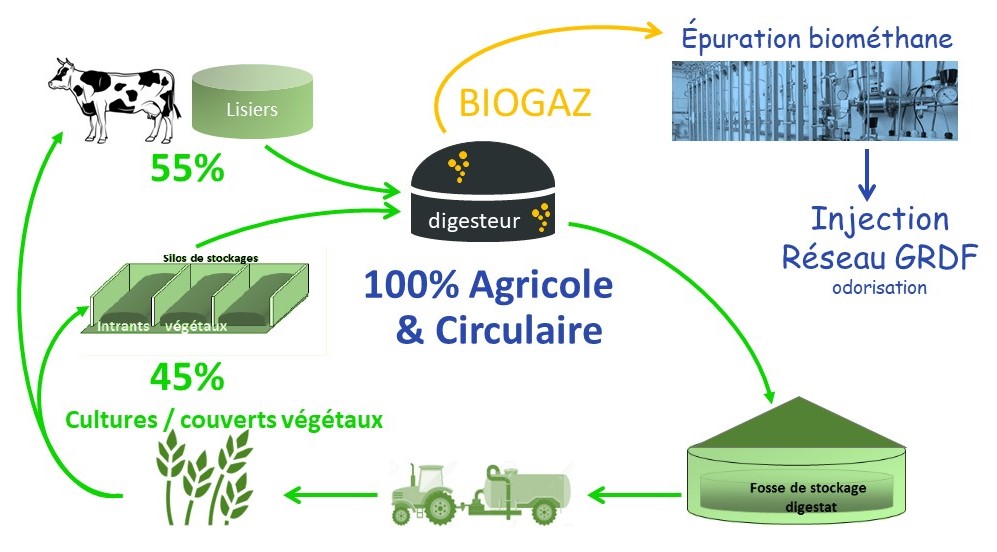
The exclusively agricultural specificity of the project is due to the fact that one of the partners runs his farm under Organic Agriculture (OA).
The specifications for crops in Organic Agriculture require the use of NON-industrial livestock effluents. The same applies to the digestate.
Digestate from anaerobic digestion is allowed in OA, on the sole condition that NO input is industrial.
This is the case for the La Chapelle-Neuve project, which derives its strength from the control of inputs exclusively from the partners’ (non-industrial) farms. No partnership with industrial entities is possible or considered to ensure this local and 100% agricultural specificity.
This autonomy over inputs is a guarantee of economic security for the banking institutions involved in financing the project..
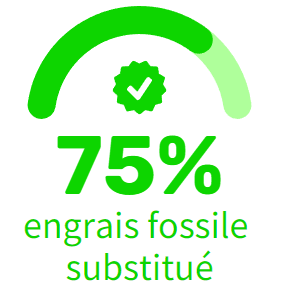
The natural process of agricultural anaerobic digestion is ensured by the microorganisms naturally present in livestock effluents.
The process, which lasts more than 80 days at 40°C, allows the mineralization of the organic nitrogen in the effluents.
A 75% reduction in the chemical or fossil fertilizer inputs needed for plant growth is expected..
Slurry is the only pumpable agricultural material that enters the anaerobic digestion process. By positioning the site at Keriven in La Chapelle-Neuve, we are acting on reducing the carbon footprint of slurry transport. Site No. 1 of Simon represents 40% of the effluents produced by dairy farms daily, approximately 10 tons/day, which do not require logistics to enter the process. In other words, 22% of the total input volumes do not need transport.
The site thus located avoids 213 slurry transports per year for export.
The production site is ideally centered relative to the logistical flows of slurry, as well as to the different sites operated by the farmers.
Thus, one ton of effluent travels only 5.1 km on average to enter the process, while an IEC (Intermediate Energy Crops) travels 9.3 km.
5.40 transports/workday are, on average annually, in transit on the site to bring in effluents or IEC or to export the digestate.
The 2 historical farms associated with the project generate 2.02 trips/workday without passing through the village center.
We thus produce 846 kWh/km of transported effluent for a diesel consumption of 10 kWh/km. In other words, the ratio « renewable energy produced / fossil energy consumed » = 85.
1.2% of fossil energy is necessary in 100% of renewable energy produced, regarding the effluents.
The ratio for IECs is 264.
0.4% of fossil energy is necessary in 100% of renewable energy produced, regarding the IECs.
The project (in La Chapelle-Neuve: 979 inhabitants in 2022) includes installations that comply with the regulatory distances to third parties.
What about agricultural odors ?
As part of its commitment to anaerobic digestion, the company TiNERZH conducted a preliminary olfactory study around the future installation site in La Chapelle-Neuve, a region steeped in a rich agricultural history. This study highlighted the presence of characteristic rural odors related to agricultural activities.
A comparative study will be conducted after the commissioning of the 100% agricultural anaerobic digestion to ensure the preservation of the local olfactory identity. Residents will be able to observe that the odors remain unchanged, as the inputs used will be identical to those already present in the surrounding agricultural operations.
The Biogaz de la Vilaine digester (near Chavagne: 4,268 inhabitants in 2020, and close to the Vilaine River) has been operating its site since 2021 without any local nuisances reported by residents.
What measures are in place to preserve the environment ?

The production site is planned on land opposite the watershed, including a biotope protection zone.
In accordance with legislation, impermeabilization under the tanks will be carried out to prevent potential leaks. The Best Available Technique (BAT) chosen to ensure this impermeability during construction will be shared with the competent authorities. This will prevent any uncontrolled discharge into the environment.
To ensure safety and preserve the environment, our anaerobic digestion project includes rigorous measures. The tanks will be equipped with double safety valves with position sensors. To ensure precise handling of the valves during dispatch operations, a safety device will require the mandatory closure of 2 valves upstream and downstream of the contaminated rainwater treatment lagoon during digestate withdrawal periods for spreading. These 2 closures will be prerequisites for authorizing the opening of the tanks for withdrawal. An automated control system for safety sensors will oversee the entire loading process. Manual valves (which duplicate the automatic valves) will be closed in case of a leak on the site while waiting for pumping for treatment. This eliminates any risk of pollution.
We will implement management and maintenance procedures to periodically ensure the good condition and functioning of the sensors and valves.
By strictly adhering to dispatch procedures and using advanced control systems, our site will be secure and serve as an example of environmental preservation.
We understand that environmental safety cannot be considered optional. It requires us to make no compromises for its preservation. Thus, our priority is to implement environmental protection measures that ensure the safety of individuals, ecosystems, and the planet as a whole.
The use of odorless digestate to replace traditional slurry is part of a continuity of responsible practices already established for the spreading of bovine slurry. This approach, aligned with previous regulatory commitments, aims at preserving biodiversity, particularly for the protection of the pearl mussel. It is important to note that the spreading limits defined in 2021 will continue to be rigorously applied, thus affirming a sustained commitment to the protection of water, soil, and living organisms as a whole.
What impacts on local employment ?

Directly, the project will employ 2 staff members at the TiNERZH site. In addition, there will be 3 jobs distributed between the CUMA de l’Evel and the ETA Thomas FRANÇOIS to ensure the planting and harvesting of IECs and the transport of effluents and digestates.
During the construction of the site, the employment of 18.8 full-time equivalent (FTE) workers is planned for one year.
The project thus generates 5 local, non-relocatable jobs.
—
Implementation of an agricultural digester and transparency for the real estate market

The study conducted in 2020 by Quelia, accompanied by Artelia and Segat, shows that the implementation of agricultural digesters is transparent for the nearby real estate market.
To view the brochure or the complete study, click HERE : https://2050.eco/immobilier/

Or scan this code

To facilitate landscape integration, the project plans to plant hedgerows and trees, which will improve visual integration while sequestering carbon.

